AI systems are experiencing a leap forward every year, with the efforts and investments of big tech companies. GPT-4 is a state-of-the-art family of language models developed by OpenAI. It’s built on the foundations of its predecessors (GPT-3 and earlier models) but offers significant improvements in language understanding.
We now have GPT-4 and GPT 4o, the latest and the most advanced language models. To have a better understanding of this new language model, we provide an in-depth guide focusing on its use, training, features, and limitations:

Updates
Since its initial release, GPT-4 has undergone significant enhancements:
- GPT-4 Turbo Introduction: In November 2023, OpenAI launched GPT-4 Turbo, a faster and more cost-effective variant of GPT-4. This model offers improved performance and supports a context length of up to 128k tokens, enabling more extensive and coherent interactions.
- Pricing Adjustments: OpenAI has revised its pricing structure to make GPT-4 more accessible:
- API Access: For models with a 128k context length (e.g., GPT-4 Turbo), the pricing is set at $10.00 per 1 million prompt tokens and $30.00 per 1 million sampled tokens.
- ChatGPT Plus Subscription: Individuals can subscribe to ChatGPT Plus for $20 per month, granting access to GPT-4, faster response times, and priority access to new features.
- ChatGPT Pro Subscription: For power users, ChatGPT Pro is available at $200 per month, offering near-unlimited access to advanced models and features.
- Expanded Accessibility: To support students, OpenAI offered free two-month ChatGPT Plus subscriptions from March 31 to May 31, 2025, aiding in final exam preparations. This initiative reflects OpenAI’s commitment to making advanced AI tools accessible to the academic community.
- Enhanced Capabilities: GPT-4 now supports multimodal inputs, allowing users to incorporate images alongside text prompts. This expansion broadens the scope of tasks GPT-4 can assist with, from analyzing visual data to generating descriptive content.
These developments underscore OpenAI’s dedication to refining GPT-4’s functionality, affordability, and user accessibility, ensuring a more robust and versatile AI experience for a diverse user base.
5 Key Features of GPT-4
1. Enhanced Language Understanding
One of GPT-4’s standout features is its ability to grasp and generate nuanced and contextually relevant responses. Unlike its predecessors, GPT-4 handles more complex conversational flows and maintains context over longer interactions, making it more effective for tasks like:
- Dialogue-based applications (e.g., virtual assistants)
- Summarization of long texts
- Complex Q&A sessions
2. Multimodal Capabilities
GPT-4 is multimodal, meaning it can process both text and images. This opens up a wide range of applications that require the integration of visual and textual information, such as:
- Image captioning: GPT-4 can generate text descriptions of images.
- Visual question answering: Users can ask GPT-4 questions about an image, and it will provide accurate answers based on its visual content.
This multimodal capability is especially useful in areas like healthcare (analyzing medical images) or creative fields (design feedback).
3. Larger and More Diverse Training Data
GPT-4 was trained on a much larger dataset than its predecessors, allowing it to:
- Handle specialized tasks: It performs well on domain-specific languages, such as medical, legal, or technical content.
- Improve coherence: The larger dataset enhances GPT-4’s ability to create more coherent and less repetitive text over long-form content.
GPT-4 is widely used for legal document analysis, scientific research summaries, and other professional tasks requiring accuracy and clarity.
4. Code Generation and Debugging
GPT-4 has significant improvements in code generation and debugging over GPT-3. It supports multiple programming languages (Python, JavaScript, C++, etc.) and can:
- Write functional code snippets: GPT-4 can generate code based on natural language descriptions.
- Debug existing code: It helps identify and fix errors, making it a valuable tool for developers looking to streamline their coding process.
5. Fine-Tuning and Customization
GPT-4 offers enhanced fine-tuning capabilities, allowing users to customize the model for specific tasks. This is particularly valuable for businesses looking to tailor the model to their industry-specific jargon or workflows.
Availability of GPT-4
GPT-4 is accessible through several platforms and services, offering a range of ways for developers, businesses, and individuals to use its capabilities:
- OpenAI API: GPT-4 is available via OpenAI’s API, which allows developers to integrate the model into their applications for tasks like text generation, chatbots, and more. Access to the API is typically based on a subscription or usage-based pricing.
- ChatGPT: GPT-4 powers OpenAI’s ChatGPT service, particularly the premium ChatGPT Plus version. Users can interact with GPT-4 directly by subscribing to ChatGPT Plus, which provides enhanced performance over the free GPT-3.5 version.
- Microsoft Integration:
- Azure OpenAI Service: GPT-4 is integrated into Microsoft’s Azure cloud services, allowing businesses to leverage GPT-4 for enterprise-level applications.
- Microsoft Copilot: Microsoft uses GPT-4 in products like Word, Excel, and Outlook through its “Copilot” feature, assisting with content creation, data analysis, and task automation.
- Custom Applications: Many companies use GPT-4 in their products and services, offering custom-built solutions in areas like customer support, content generation, and automation.
Access and Pricing
- Access to GPT-4 is generally through paid plans, either via OpenAI’s API or through Microsoft’s services.
- Pricing typically depends on usage (number of tokens processed), making it scalable for different types of users.
How GPT-4 Works?
GPT-4, like its predecessors, is based on the Transformer architecture, which is a type of deep learning model designed to process and generate text. Here’s a detailed look at how GPT-4 works:
1. Transformer Architecture
The core of GPT-4 is built on the Transformer model, which was introduced in a 2017 paper by Vaswani et al. This architecture has since become the foundation for many state-of-the-art language models.
1.1 Self-Attention Mechanism
- Self-Attention: The Transformer model employs a self-attention mechanism that enables the model to assess the relative importance of different words within a sentence. This means that when GPT-4 processes a sentence, it doesn’t just look at words in isolation but considers their relationships with every other word in the sentence.
- Multi-Headed Attention: To capture different aspects of these relationships, the Transformer uses multi-headed attention, which allows the model to focus on various parts of the sentence simultaneously.
1.2 Layers and Depth
- Stacked Layers: GPT-4 consists of multiple layers of self-attention mechanisms and feedforward networks. Each layer refines the model’s understanding of the input text, making its predictions more accurate and contextually appropriate as data passes through the layers.
- Depth: The model’s depth refers to the number of layers it has. GPT-4 is significantly deeper than its predecessors, with hundreds of layers, allowing it to capture more complex patterns and relationships in the data.
2. Training Process
GPT-4 is trained using a process known as unsupervised learning, specifically designed to predict the next word in a sequence of text. Here’s how the training process works:
2.1 Pretraining
- Large-Scale Text Corpus: GPT-4 was pretrained on an extensive dataset comprising diverse text sources, including books, articles, websites, and other written content. This training data spans a wide range of topics, styles, and languages.
- Objective: During pretraining, GPT-4 learned to predict the next word in a sentence given all the previous words. For example, if the input is “The cat sat on the,” the model tries to predict “mat” as the next word.
- Tokenization: The text is broken down into tokens, which are smaller chunks of data (such as words or subwords). GPT-4 learns to process and generate sequences of these tokens.
2.2 Fine-Tuning
- Specialized Datasets: After the initial pretraining phase, GPT-4 can be fine-tuned on more specific datasets to adapt to particular tasks or domains. This fine-tuning process makes the model more adept at tasks like translation, summarization, or code generation.
- Supervised Learning: During fine-tuning, supervised learning techniques may be used. In these, the model is trained on examples with known correct outputs, further refining its capabilities.
3. Model Size and Parameters
GPT-4 is much larger than its predecessors, with a significant increase in the number of parameters (which are the adjustable weights within the model). These parameters enable the model to store vast amounts of information and patterns from the training data.
- Parameters: GPT-4 has hundreds of billions of parameters, making it one of the largest language models ever created. The sheer number of parameters allows GPT-4 to generate more nuanced and contextually accurate text.
- Scaling: The large model size also means GPT-4 can process longer contexts, handle more complex queries, and generate higher-quality outputs compared to smaller models.
4. Inference and Text Generation
When GPT-4 generates text, it does so by predicting one token at a time. Here’s how the process works:
4.1 Contextual Understanding
- Input Prompt: The process begins with an input prompt provided by the user. This could be a question, a statement, or any text that sets the context for the response.
- Contextual Processing: GPT-4 processes the entire prompt using its layers of self-attention and feedforward networks, which helps it understand the context and intent behind the prompt.
4.2 Token Prediction
- Sequential Generation: GPT-4 generates text one token at a time. After predicting the first token, it uses that token as part of the context to predict the next one, and so on. This sequential approach allows GPT-4 to generate coherent and contextually appropriate text.
- Probability Distribution: For each token, GPT-4 calculates a probability distribution over the possible next tokens, selecting the one with the highest probability (or sampling from the distribution if randomness is desired).
5. Multi-modal Capabilities
GPT-4 extends beyond just text generation and can handle multi-modal tasks, such as processing images or combining text and image data.
- Image Processing: GPT-4 can analyze images, generate descriptive text based on images, or even create images based on textual descriptions.
- Cross-Modal Interactions: The model can integrate information across different modalities, such as using text prompts to influence image generation or describing visual content in text.
7 Distinctive features of GPT-4
1- Visual input option
Although it cannot generate images as outputs, it can understand and analyze image inputs. GPT-4 has the capability to accept both text and image inputs, allowing users to specify any task involving language or vision. It can generate various types of text outputs, such as natural language and code, when presented with inputs that include a mix of text and images.
Video: GPT-4 understanding the visual input and producing text output
GPT-4 with visual input
GPT-4 demonstrates similar abilities when processing input that includes both text and visual elements in various domains, including documents containing text, photographs, diagrams, or screenshots.
However, GPT-4’s visual input option is not currently available to users on ChatGPT. OpenAI is working on implementing this to the chatbot.
2- Higher word limit
Figure 5. The comparison of ChatGPT with GPT-3.5 and GPT-4 in terms of word limit
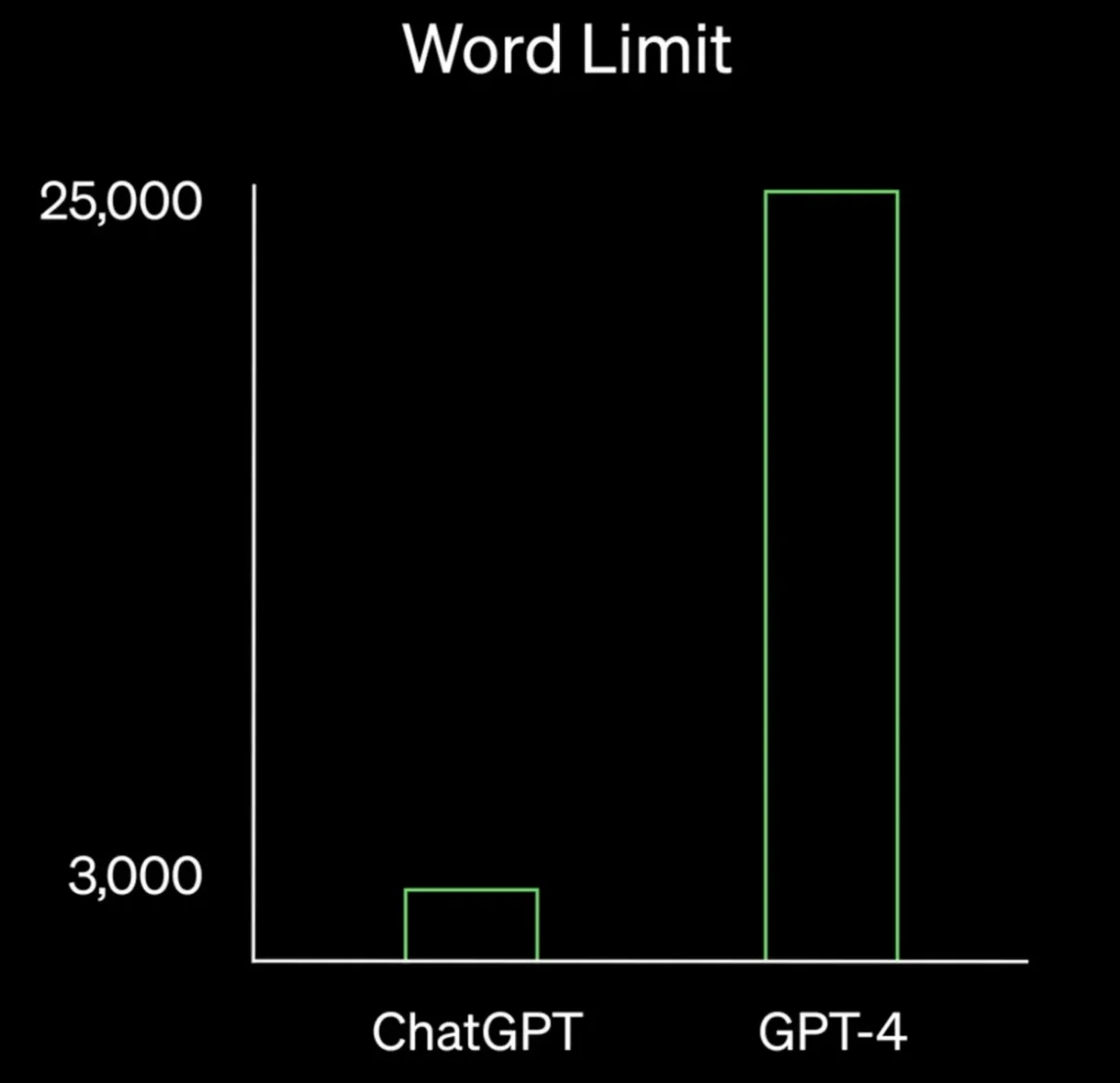
Source: OpenAI
GPT-4 can process more than 25,000 words of text (see Figure 5 above), making it suitable for a variety of use cases, such as:
- Creating long-form content
- Carrying out extended conversations
- Conducting document analysis and search tasks (Figure 6)
3- Advanced reasoning capability
GPT-4 is outstanding compared to the earlier versions with its natural language understanding (NLU) capabilities and problem solving abilities. The difference may not be observable with a superficial trial, but the test and benchmark results show that it is superior to others in terms of more complex tasks.
As an example, OpenAI tested the large language models in a simulated bar exam. GPT-4’s bar exam results show that it scored in the top 10% of test-takers, while GPT-3.5’s score was in the bottom 10%.1 Overall, the performance of GPT-4 on various professional exams outperformed that of GPT-3.5 (Figure 7).
Figure 7. The comparative analysis of exam results of the three GPT models
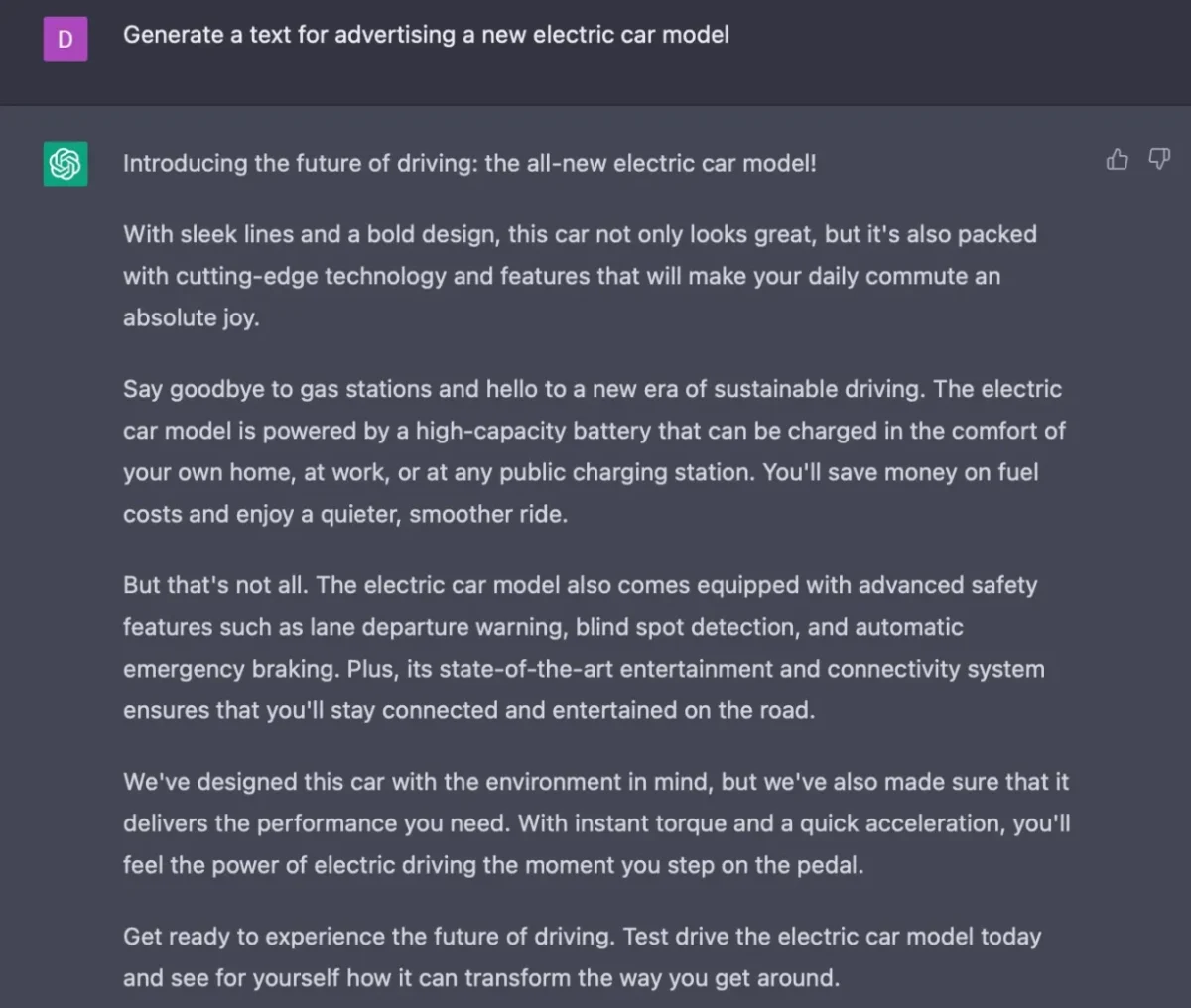
Source: OpenAI
4- Advanced creativity
As a result of its higher language capabilities, GPT-4 is advanced in creativity compared to earlier models (Figure 7). This can make the language model more adaptive to certain use cases that require creative writing skills, such as:
- Screenplay writing
- Blog post creation
- Essay writing
Figure 8. GPT-4 produces an an output for a highly complex task that requires not only expertise but also creativity
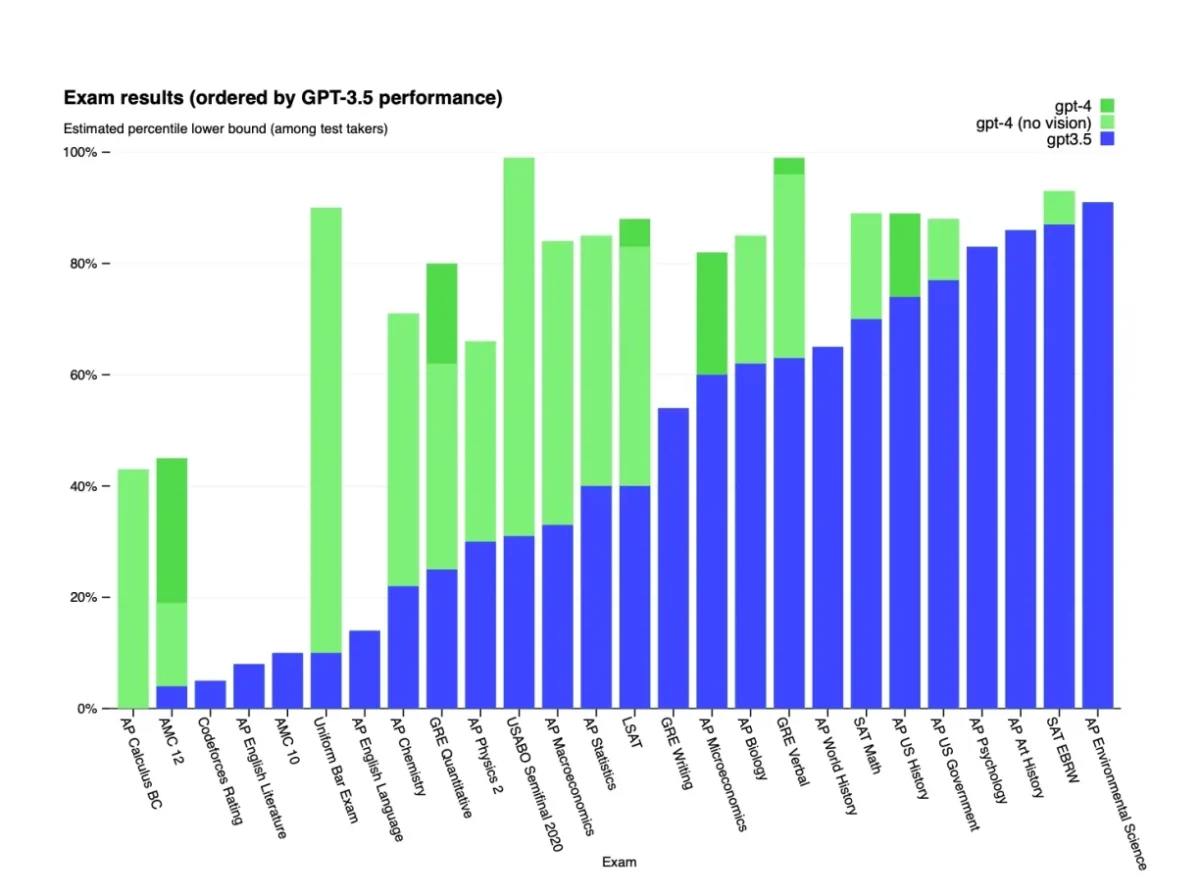
Source: OpenAI
5- Adjustment for inappropriate requests
ChatGPT was criticized for its handicap in terms of providing answers to inappropriate requests such as explaining how to make bombs at home, etc. OpenAI was working on this problem, and made some adjustments to prevent the language models from producing such content.
According to OpenAI, GPT-4 is 82% less likely to respond to requests for disallowed and sensitive content (Figure 9).2
Figure 9. A comparison of the language models in terms of their tendency to produce responses to inappropriate requests
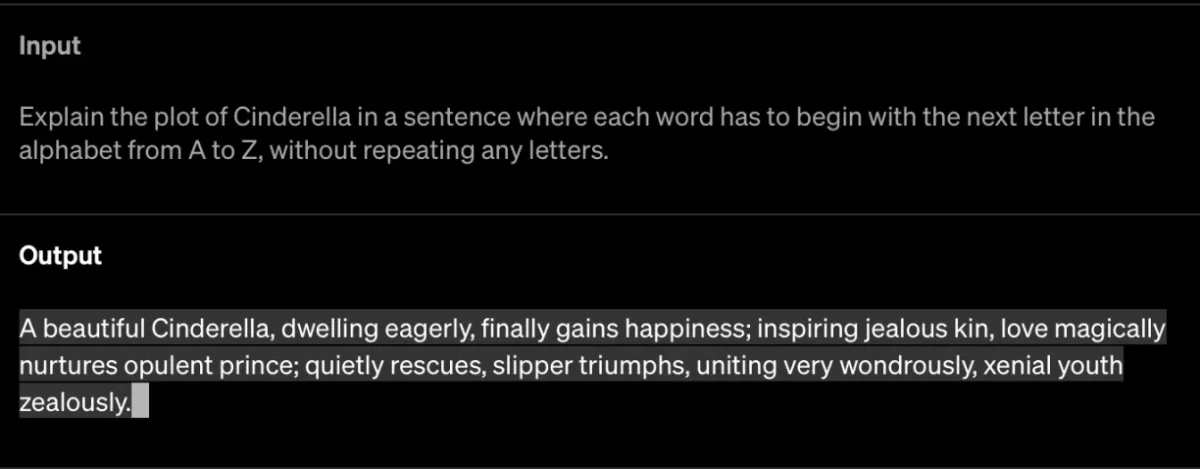
Source: OpenAI
6- Increase in fact-based responses
Another limitation of the earlier GPT models was that their responses were not factually correct for a substantive number of cases. OpenAI announces that GPT-4 is 40% more likely to produce factual responses than GPT-3.5.
Figure 10. A comparison of GPT models in terms of their performance to produce factually-correct responses
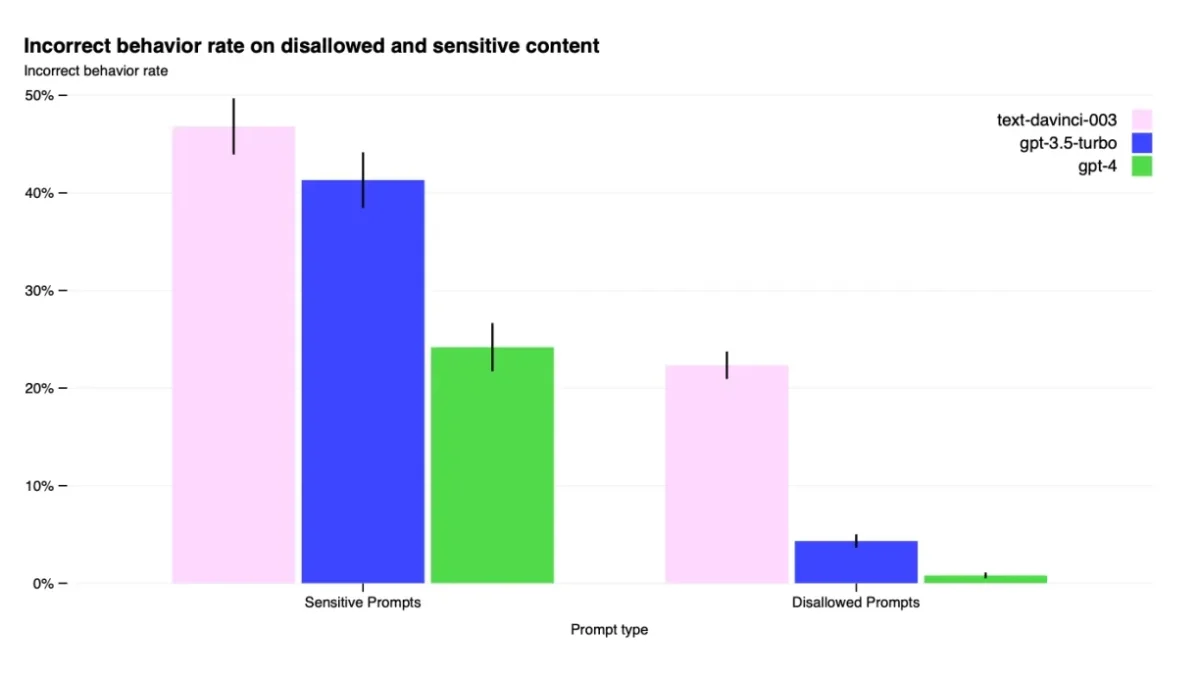
Source: OpenAI
7- Steerability
“Steerability” is a concept in AI that refers to its ability to modify its behavior as required. This capacity can be valuable, such as when the model needs to act as a compassionate listener, but it can also be risky if individuals convince the model that it has negative qualities, such as being malicious or depressed.
GPT-4 incorporates steerability more seamlessly than GPT-3.5, allowing users to modify the default ChatGPT personality (including its verbosity, tone, and style) to better align with their specific requirements (Figure 11).
How GPT-4 Works
1. The Transformer Architecture
The core of GPT-4, like its predecessors, is based on the Transformer architecture, first introduced by Google in 2017. The Transformer architecture revolutionized NLP by making it more efficient and scalable, and it has become the foundation for most modern language models. Here’s how it works:
Self-Attention Mechanism
- Self-attention allows the model to weigh the importance of different words in a sentence or input, considering how each word relates to the others.
- This mechanism lets GPT-4 focus on the most relevant parts of the input when generating an output, allowing it to better understand the context.
For instance, in the sentence “The dog chased the cat because it was hungry,” the model must figure out that “it” refers to the dog, not the cat. The self-attention mechanism helps GPT-4 to focus on this kind of detail.
Multi-Layered Network
- GPT-4 consists of multiple layers (hundreds or even thousands) of these self-attention modules, enabling it to model complex relationships between words and phrases.
- The more layers it has, the deeper the model can process context and make sophisticated predictions.
Each layer in GPT-4 refines the previous layer’s understanding of the input, allowing it to generate increasingly accurate outputs as it progresses through the layers.
2. Pre-Training: Learning from Large Datasets
GPT-4 undergoes a two-stage process: pre-training and fine-tuning.
Pre-Training
- During pre-training, GPT-4 is exposed to a massive corpus of text data from books, websites, scientific articles, and other sources.
- The model learns to predict the next word in a sentence, which helps it build an understanding of grammar, facts, and even some reasoning abilities.
For example, if GPT-4 is given the prompt “The sky is blue because…”, the model has learned that plausible completions might be “of the way light interacts with the atmosphere.” It achieves this by recognizing patterns in the data it was trained on.
Tokenization
- GPT-4 breaks down text into tokens—smaller pieces of words or characters that it processes.
- Instead of learning from words directly, it works with these tokens to better understand and generate text. This approach helps GPT-4 handle uncommon words and spelling variations and even generate creative text more effectively.
3. Fine-Tuning: Customizing the Model
After the pre-training phase, GPT-4 undergoes fine-tuning, where it is further trained on more specific, high-quality datasets for specialized tasks, such as answering questions, providing customer support, or generating code. This phase helps to tailor GPT-4’s general language abilities for specific applications.
Supervised Fine-Tuning
- In supervised fine-tuning, the model is trained with examples of inputs and correct outputs. For instance, GPT-4 might be shown an input like “What is the capital of France?” and trained to produce the output “Paris.”
Reinforcement Learning with Human Feedback (RLHF)
- GPT-4 also uses Reinforcement Learning with Human Feedback (RLHF), where humans rate the model’s responses and provide feedback to help it improve over time.
- This helps GPT-4 align better with human values, improve answer quality, and reduce harmful or biased outputs.
4. How GPT-4 Generates Responses
When you interact with GPT-4, the model follows a process to generate responses:
Input Encoding
- GPT-4 first converts the input text into tokens (smaller units of text) and processes them to understand the sequence of words.
Contextual Understanding
- The self-attention mechanism kicks in, where GPT-4 weighs each word’s importance relative to the others in the input.
- It maintains context over longer conversations by considering previous inputs and their relevance to the current query.
Next-Token Prediction
- GPT-4 then uses its understanding of the input to predict the next token (or word) based on probabilities. It generates the next word or phrase step by step, continually refining its response.
For example, if you ask GPT-4, “What are the benefits of AI?”, the model predicts tokens like “efficiency”, “automation”, and “improved decision-making” based on the patterns it has learned during pre-training.
Post-Processing
- Once the model generates its output, it converts the tokens back into human-readable text and presents it as a response.
This process happens extremely quickly, enabling GPT-4 to produce coherent and contextually appropriate responses in real-time.
5. Multimodal Abilities in GPT-4
One of the breakthroughs in GPT-4 is its multimodal capability, which allows it to process not only text but also images. Here’s how it works:
Image Input and Processing
- When GPT-4 is provided with an image, it first converts it into numerical data (pixels) that the model can understand.
- It then uses a modified form of the Transformer architecture to process visual information similarly to how it processes text.
Text-Image Integration
- GPT-4 can generate text that describes an image or answers questions about the image. For example, it can analyze a picture of a graph and explain the trends it shows.
This multimodal capability makes GPT-4 more versatile, allowing it to handle tasks like generating image captions, answering visual questions, or even interpreting complex visual data, such as medical scans.
6. Training Data and Knowledge Cutoff
Training Data
- GPT-4 is trained on an extensive dataset that includes publicly available text data from books, websites, scientific papers, and more. However, GPT-4 is not connected to the internet and cannot fetch real-time information.
- The model has a knowledge cutoff date, meaning that GPT -4 is not aware of any events, facts, or discoveries after that date. For 2024, GPT-4’s knowledge is generally current until 2023.
Handling Knowledge Gaps
- To fill in knowledge gaps post-training, users need to provide updated information or ask specific questions within the model’s knowledge range.
7. Handling Complex Queries and Tasks
GPT-4 has a strong ability to manage complex tasks and queries, including:
- Multistep Reasoning: It can solve math problems, analyze logical statements, and break down complex topics.
- Creative Generation: GPT-4 can generate creative text such as poetry, stories, essays, and more, while maintaining context.
- Code Writing: Developers use GPT-4 to write, debug, and optimize code in multiple languages.
GPT-4 uses its training on vast amounts of text to mimic reasoning patterns, allowing it to handle diverse challenges, from everyday queries to more specialized tasks.
GPT-4 uses a combination of advanced Transformer architecture, self-attention mechanisms, and reinforcement learning to produce human-like text and even process multimodal inputs like images. It learns from massive datasets and refines its responses through both supervised learning and user feedback. This powerful combination enables GPT-4 to handle complex tasks across various industries, revolutionizing everything from customer service to creative writing and code generation.
The success of GPT-4 lies in its ability to generate meaningful and contextually appropriate responses, opening up a new realm of possibilities for AI applications in 2024 and beyond.
Pricing and Plans
ChatGPT-4 Pro Plan:
- $20/month (as of 2024).
- Offers access to GPT-4, priority response times, and multimodal capabilities.
API Pricing:
- Pay-as-you-go pricing model, based on tokens (words/characters processed).
Latest Innovations, Challenges, and Strategic Developments
OpenAI has improved the experience for free ChatGPT users by introducing an advanced voice mode that mimics human response speed. Initially available only to Plus and Team subscribers in the U.S., this feature has expanded globally and is now accessible on macOS and Windows desktop applications. Plans are underway to make it available to free users as well. The enhancements include new personalized voices, improved fluency in multiple languages, and customizable settings for more accurate responses. OpenAI is also working on preventing interruptions during speech and responding to user feedback to make AI interactions more natural and adaptable.
2. Integration with Financial Institutions
BBVA, Spain’s second-largest bank, has integrated ChatGPT Enterprise, deploying 3,000 licenses to enhance productivity through custom “GPTs” for various tasks.
While initial results are promising, challenges remain in scaling and deeper integration with complex systems. The bank has observed increased creativity among employees but remains cautious about long-term tangible returns.
The true impact on BBVA’s bottom line and seamless integration with internal databases are still uncertain. OpenAI’s success with enterprises, particularly in financial services, is crucial, given its over one million business clients. BBVA plans to expand its ChatGPT use but remains aware of potential adoption issues among a broader user base.
3. Advancements in AI Model Development
The rapid development of large language models (LLMs) in artificial intelligence faces unexpected delays and challenges, potentially slowing down progress. This shift deviates from the belief that increasing model size, data, and computing power would continuously improve AI capabilities. Prominent AI companies like OpenAI, Google, and Anthropic are experiencing plateaued results from LLM training, raising concerns about oversaturation in data and hardware limits.
Nvidia, crucial to the AI revolution, faces issues with its Blackwell GPUs overheating, which affects their efficiency. Despite these hurdles, some key industry figures like Sam Altman of OpenAI and Eric Schmidt remain optimistic, dismissing notions of an impending “AI winter” or slowdown. Investors are closely monitoring Nvidia’s financial results due to the high stakes and significant investments in AI startups and hardware companies.
4. OpenAI’s Strategic Investments
SoftBank has invested $500 million in OpenAI, citing the company’s maturity, stronger revenue base, and shift towards a for-profit entity as reasons for the timing. OpenAI has raised $6.6 billion, reaching a valuation of $157 billion, with other investors including Microsoft and Tiger Global. Since launching ChatGPT, OpenAI’s revenue is projected to hit $3.7 billion this year, with 350 million monthly active users.
OpenAI’s partnership with Microsoft and Apple, as well as continued development in AI training and API monetization, are key to managing costs and growth. Despite challenges such as high capital expenditures and leadership changes, SoftBank remains optimistic about OpenAI’s potential and is open to investing in other AI companies.
5. Microsoft’s AI Integration
Microsoft, celebrating its 50th anniversary, has undergone a significant transformation under CEO Satya Nadella, evolving into a significant player in artificial intelligence and open-source while grappling with several challenges.
The partnership with OpenAI, starting in 2019 with a $1 billion investment and culminating in extensive integration of AI capabilities, epitomizes this shift, solidifying Microsoft’s forefront position in AI. AI integration has led to the launch of products like GitHub Copilot and GPT-4 powered Bing, positioning Microsoft ahead in the AI race against competitors such as Google. Despite these successes and reaching a valuation of $3 trillion, Microsoft faces scrutiny for persistent anticompetitive practices and recent cybersecurity failures, highlighting the company’s mix of innovative triumphs and enduring issues.
FAQ
What is GPT-4?
Generative pre-trained transformer 4 is OpenAI‘s latest language model under GPT series, released on March 14, 2023. Microsoft has confirmed that certain versions of Bing that utilize GPT technology were utilizing gpt-4 prior to its official release.3 GPT 4o is OpenAI’s latest flagship model introduced in 2024.
How was GPT-4 trained?
The deep learning training of GPT-4 took place on the AI supercomputers of Microsoft Azure. Azure’s infrastructure, which is optimized for AI, also enables the distribution of GPT-4 to users worldwide.4 Similar to earlier GPT models, the GPT-4 base model was trained to anticipate the next word in a given text and was trained on a mixture of publicly available data, such as internet data, and proprietary data that we have licensed. However, GPT-4 has a slightly but importantly different advantage in training:
Training with human feedback
Although the base model can generate a broad range of answers when prompted with a question, many of which may not align with the user’s intended meaning, they refine the model’s behavior through reinforcement learning with human feedback (RLHF) to ensure that it stays within certain boundaries that are consistent with the user’s objectives.
OpenAI utilized feedback from human sources, including human feedback provided by users of ChatGPT, to enhance the performance of GPT-4. They also collaborated with more than 50 specialists to obtain initial feedback in various areas, such as AI safety and security.
What were the previous models before GPT-4?
GPT-1 (2018): The original model, introduced the idea of large-scale pre-training for language models.
GPT-2 (2019): Scaled up significantly, demonstrating the power of large models in generating coherent, contextually relevant text.
GPT-3 (2020): Marked a revolutionary increase in capabilities with its 175 billion parameters, excelling in few-shot learning and being widely adopted in AI applications.
GPT-3.5 (2022): An incremental step with a focus on conversational abilities and instruction-following.
GPT-4 (2024): The most advanced iteration, with enhanced multimodal processing, improved language understanding, and better domain-specific performance.
What are the limitations of GPT-4?
GPT-4, while highly advanced, still has several limitations:
Bias and Ethical Concerns: Like previous models, GPT-4 can generate biased or harmful content due to biases in its training data. Mitigating these biases remains a challenge.
Knowledge Cutoff: GPT-4’s knowledge is current only up to 2023, meaning it cannot provide real-time information or recent developments.
Inaccuracy: While improved, GPT-4 can still produce incorrect or nonsensical answers, especially for complex or ambiguous questions.
Resource Intensive: Running GPT-4 at scale requires significant computational resources, making it expensive to deploy for certain tasks.
Limited Multimodal Capabilities: Although GPT-4 can process both text and images, its ability to handle complex multimodal tasks is still evolving and can be limited.
Contextual Retention: GPT-4 can struggle with maintaining context over very long conversations or texts, leading to occasional loss of coherence.
These limitations highlight the need for cautious and responsible use of GPT-4 in real-world applications.
External Links
- 1. “GPT-4.” OpenAI, 14 March 2023, https://openai.com/research/gpt-4. Accessed 27 March 2023.
- 2. Supra note 3.
- 3. OpenAI GPT-n models: Advantages & Shortcomings in 2025. AIMultiple
- 4. Introducing GPT-4 in Azure OpenAI Service | Microsoft Azure Blog. Microsoft Azure Blog


Comments
Your email address will not be published. All fields are required.